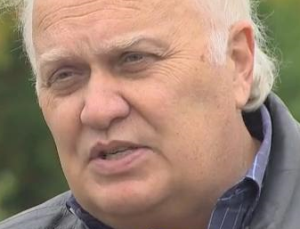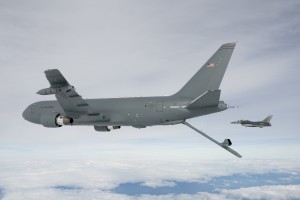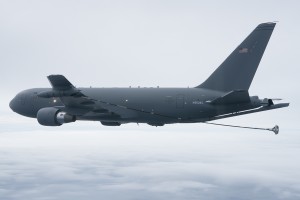Leeham News and Analysis
There's more to real news than a news release.
New KC-46A delay means more charges probable
Subscription Required
Introduction
May 30, 2016, © Leeham Co.: It’s the classic maneuver to bury bad news: Boeing

Boeing KC-46A. Source: National Defense Magazine via Google images.
announced on Friday, the start of the three-day Memorial Day weekend that its KC-46A tanker will be delayed yet again. Only 16 days earlier, Boeing CEO Dennis Muilenburg said the tanker was on time under a schedule that had been revised previously.
That wasn’t all, according to the announcement. Even when the tankers are delivered, the wing pod refueling systems won’t be operational. (The Boeing statement is below the jump.)
If all this has a familiar ring, it should.
The previous version of the KC-46A, the KC-767 International Tanker, was delayed four years in part because of flutter issues with the pod refueling systems.
Only eight of these tankers were built: four for the Italians and four for the Japanese. Boeing took huge write-offs for these tankers.
Summary
- Will the latest delay be the last?
- Boeing is building tankers despite the need for rework and some internal design changes.
- Are we facing the prospect of a new set of “Terrible Teens”?
- Another write-off is probable-and it may not be the last.
- Will the full USAF tanker procurement yield a profit on the sale?
Boeing 1Q results reveal “underlying strength”
April 27, 2016: Boeing delivered better financial results in first quarter that reflect “underlying strength” in the company, said Dennis Muilenburg, CEO of The Boeing Co., on the first quarter earnings call.
Excluding charges of $243m pre-tax charges on the KC-46A tanker, earnings per share equaled last year. Charges related principally to engineering change to the completed tankers, required after flight testing began. Muilenburg said the program remains “on path” to meet the commitment to deliver 18 tankers by August 2017. With a potential program of 400 deliveries over the life of the program, Muilenburg said the program should be profitable.
Pontifications: Catching up on the KC-46A, KC-30A
April 11, 2016, © Leeham Co.: The Government Accountability Office (GAO) concludes that the Boeing KC-46A aerial refueling tanker for the US Air Force has “challenging testing and delivery schedules” ahead in its annual review of the program.
It’s been a long, long time since I wrote about aerial refueling tankers. Having delved into this topic during the long-running saga of the USAF recapitalization effort, and the competitions between Northrop Grumman/EADS and later Airbus alone and Boeing, the topic had been beaten to death.
But as we who follow such things know, Boeing’s current effort to build the winning KC-46A for the Air Force has run into more than a few problems. These have led Boeing to be at least eight months late and write off $1.2bn pre-tax on the program.
And the problems aren’t over.
Pontifications: Boeing’s 8,000 employee reduction isn’t nearly enough
April 4, 2016, © Leeham Co.: Boeing’s plans to reduce head count at Boeing Commercial Airplanes by 8,000 jobs this year dominated the news last week. Comparing employment figures with Airbus Commercial shows this reduction isn’t nearly enough.
BCA has 22% more employees per airplane than Airbus. BCA is a bloated organization. Some of this undoubtedly is inherent to being a 100 year old company, compared with Airbus being less than 50. Airbus is more automated than Boeing as well.
Airbus only one reason for Boeing cost-cutting
- The bigger danger at Boeing is not Airbus pricing, but the potential for up to 15,000 early retirements this year by engineers, technicians and touch-labor. See Scott Hamilton’s column at Forbes online.
- Job cuts drive margin at Boeing, analyst concludes.
March 31, 2016, © Leeham Co.: Boeing has to cut costs. So it’s cutting 10% of its work force.
The reason?

Ray Conner, CEO of Boeing Commercial Airplanes. Photo via Google images.
Pricing pressure from Airbus, says Ray Conner, the CEO of Boeing Commercial Airplanes (BCA). The Seattle Times, which reported March 30 that it obtained an internal memo citing the 10% number, quoted Conner extensively from a Feb. 10 internal webcast that Boeing is losing orders to Airbus over price.
Declining market share, especially for the 737, is a major concern, The Times quotes Conner.
“Their biggest weapon that they’re using in the competitions today is price,” Conner told employees. “They are attacking us with price in every single campaign. And as a result of that, you know, we’re being pushed to the wall,” Dominic Gates of The Seattle Times wrote, citing a transcript of Conner’s internal comments.
Gates went on to write that “In justifying the anticipated cuts to employees in last month’s internal webcast, Conner was unusually frank as he invoked a dire threat from Airbus.
“He said that Airbus winning 63 percent of single-aisle sales last year with its A320 jets going against Boeing’s 737 jets was ‘alarming … because the 737 is the biggest contributor to the earnings of the Boeing Company.’”
Gates went on to extensively quote Conner in his article and the defensive posture Boeing is now in vis-à-vis Airbus.
Pontifications: Dissecting Boeing’s 2016 delivery guidance
Feb. 8, 2016, © Leeham Co.: Boeing’s surprise guidance for 2016 for fewer deliveries on the 737 and 767 lines raised as many questions as officials answered on the Jan. 27 earnings call.
The lower guidance led to about a 9% drop in stock, from $128 to $115. As of Friday, the stock had recovered some, trading in the low $120s.
Boeing’s explanation about the lower guidance for 737 deliveries—12 fewer this year than in 2015—seemed, on the surface, reasonable. As the 737 MAX entered production, both with test aircraft and the first production airplanes, officials said this will lead to fewer deliveries of the NG.
But as stock analysts digested the information, skepticism arose. David Strauss of UBS issued a note last week in which he concluded the real reason for the lower deliveries is a likely production gap—not enough NG sales were achieved to bridge the gap from the NG to the MAX.
Pontifications: A sea change at Boeing
Jan. 18, 2016, © Leeham Co. The surprise announcement last week of a tentative contract agreement between Boeing and its engineers union, SPEEA, was the best news coming out of the company that I’ve heard in years.
Boeing 737 rate hike factors

Boeing 737 factory in Renton (WA). Boeing rendering.
Subscription Required
Introduction
Nov. 30, 2015, © Leeham Co.: As Boeing ponders whether to increase production rates of the 737 line beyond the previously announced 52/mo rate effective in 2018, there are other important considerations besides whether the market can sustain another rate increase and whether the supply chain can gear up to the higher rates.
It is widely known that Boeing is considering rates as high as 63/mo, the maximum capacity at its Renton (WA) plant. Airbus has already announced it plans to go to rate 60/mo for the A320 family in 2019. But a higher rate is being explored, and a relationship to the future of the 747-8 is a factor.
Summary
- Market share protection, backlog clear considerations.
- Termination of the 747-8 program, its effect on suppliers and a Boeing write down are factors.
- Cash flow going into the 2020 decade is important.
KC-46A refueling boom, drogue testing
Oct. 13. 2015: The US Air Force and Boeing released photos of the KC-46A aerial refueling tanker with the boom and the drogue deployed. Photos by John D. Parker. Click on images to enlarge.






